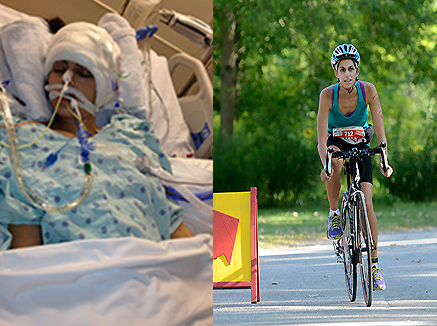
At left, Dina Pestonji after emergency brain surgery, and right, Pestonji cycling. She has not only learned to walk again - she's now competing in races. (Photo at left: Dina Pestonji; Photo at right: MySportsShooter.com)
After working abroad, Dina Pestonji was excited to begin a new life in Toronto.
At 29, she was in the midst of moving into her new downtown condo and starting a career in financial technology sales.
That’s when, in December 2012, she started getting major headaches and shooting pain from her neck down to her legs.
“At first, I thought it was the flu,” remembered Dina. “Then, two days after Christmas, my speech became slurred.”
Her family brought her to the local emergency department and she was soon transferred to Toronto Western Hospital.
She stayed in the hospital for a week where multiple tests were done. None could indicate what was wrong and Dina returned home.
Convulsions
The next morning, she woke up at home and was unable to move her right arm or ride side of her face. When she went to
check into Toronto Western’s Emergency Department, she began convulsing and lost consciousness.
“Dina’s father and I faced the critical life and death decision of whether she should have brain surgery,” said Shahnaz Pestonji, Dina’s mother.
Toronto Western Hospital neurosurgeon Dr. Mojgan Hodaie performed emergency brain surgery on Dina – the same day she was to start her new job.
“Her life was at risk and we only had a very short time to save it,” said Dr. Hodaie. “It was devastating for Dina, her family and the neurosurgery team to see someone so young and healthy suddenly so sick and need urgent brain surgery.”
Dina had suffered a rare stroke. The surgery relieved the pressure the stroke put on the brain.
When she awoke from surgery, she couldn’t talk or use the right side of her body.
“The hardest part was not being able to communicate,” said Dina, “and, not knowing if I ever would. My dreams of starting a new life in Toronto were shattered.”
'Greatest fear'
After almost four weeks of recovery at Toronto Western, she was stable enough to transfer to inpatient stroke rehab at Toronto Rehab where she recovered for one and half months.
She focused on learning how to talk again and navigate her walking.
“After my surgery my voice sounded like a robot,” said Dina. “I wasn’t sure if I’d ever talk properly again, and have my personality back. My speech language pathologist worked with me to gain back my communication skills, but it took time. I was so relieved when it started coming back.”
Dina’s brain surgery left her exhausted. But, she was also determined to relearn her walking skills.
“Beyond walking, my greatest fear was that I wouldn’t be able to run again,” said Dina, who competed in half-marathons before her stroke. “It was a pipe dream.”
“When Dina came to rehab she was physically able to walk, but had lost a lot of her confidence,” explained Jeremy Griffiths, Dina’s inpatient physiotherapist. “The balance tests showed that she had lost some motor control making higher balance activities - standing on one leg and coordination – more difficult.”
Although Dina was able to walk, she had to wear a protective helmet because of the missing skull flap that was removed during her brain surgery.
“She was highly motivated and was soon walking the halls of the hospital with her parents for extra practice, which is so important for recovery,” said Griffiths.
Dina explained to Griffiths that she was a runner and she wanted to return to it.
“In a few physiotherapy sessions we would incorporate jogging,” said Griffiths. “Dina learned quickly and I had to vary her exercises daily to challenge her effectively.”
“It was great working with Jeremy,” said Dina. “Most of the patients on the unit were 50 years or older. Jeremy was younger and understood how I learned best, related to me and kept me engaged in my rehab.”
Achieving dreams
Only a few months after leaving Toronto Rehab and having her second brain surgery to reattach her skull flap, Dina overcame her fear and completed her first duathlon on August 25 of this year.
She’s not stopping there. She will also run the Scotiabank Waterfront half-marathon on October 20.
“I’m a marathon runner and I know how hard it is,” said Griffiths. “It’s amazing Dina can run that distance and manage to dodge around all of the people, which is part of marathon running. I’m really proud of her. It’s incredible.”
In addition to running, she’d also hoped to attend her sister’s graduation and to travel Europe.
She did both.
“Dina is a young woman, who was very accomplished and was suddenly faced with a catastrophic event,” said Griffiths. “She remained calm and took it in stride. You could see her strength.
Related
Toronto Star: Stroke patient to run Scotiabank Toronto Waterfront Marathon
Facebook album: Road to Recovery- Dina Pestonji
